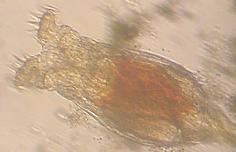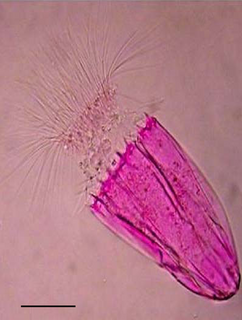
Loricifera is a phylum of very small to microscopic marine cycloneuralian sediment-dwelling animals that had been determined to be 37 described species, in nine genera, but in 2021 has increased to 43 species. Aside from these described species, there are approximately 100 more that have been collected and not yet described. Their sizes range from 100 μm to ca. 1 mm. They are characterised by a protective outer case called a lorica and their habitat is in the spaces between marine gravel to which they attach themselves. The phylum was discovered in 1983 by Reinhardt Kristensen, near Roscoff, France. They are among the most recently discovered groups of Metazoans. They attach themselves quite firmly to the substrate, and hence remained undiscovered for so long. The first specimen was collected in the 1970s, and later described in 1983. They are found at all depths, in different sediment types, and in all latitudes.
Reinhardt Møbjerg Kristensen is a Danish invertebrate biologist, noted for the discovery of three new phyla of microscopic animals: the Loricifera in 1983, the Cycliophora in 1995, and the Micrognathozoa in 2000. He is also considered one of the world's leading experts on tardigrades. His recent field of work revolves mostly around arctic biology.

A hydrogenosome is a membrane-enclosed organelle found in some anaerobic ciliates, flagellates, and fungi. Hydrogenosomes are highly variable organelles that have presumably evolved from mitochondria to produce molecular hydrogen and ATP in anaerobic conditions.

Scalidophora is a group of marine pseudocoelomate protostomes that was proposed on morphological grounds to unite three phyla: the Kinorhyncha, the Priapulida and the Loricifera. The three phyla have four characters in common — chitinous cuticle that is moulted, rings of scalids on the introvert, flosculi, and two rings of introvert retracts. However, the monophyly of the Scalidophora is not supported by molecular studies, where the position of the Loricifera was uncertain or as sister to the Panarthropoda. Both studies supported a reduced Scalidophora comprising the Kinorhyncha and Priapulida as sister phyla. Their closest relatives are the Panarthropoda, Nematoda and Nematomorpha; thus, they are placed in the group Ecdysozoa.

Gnathifera is a clade of generally small spiralians characterized by complex jaws made of chitin. It comprises the phyla Gnathostomulida, Rotifera, Micrognathozoa, and Chaetognatha. It may also include the Cycliophora.

Spinoloricus cinziae is an animal species described in 2014 in the phylum Loricifera.

Cyclorhagida is an class of kinorhynchs, which are small marine invertebrates.
Australoricus oculatus is a species of Loricifera, a species of microscopic marine sediment-dwelling animals, in the family Nanaloricidae. It is the only described species in the genus Australoricus. It was discovered in sea caves off New South Wales in Australia.

Pliciloricus enigmaticus is a marine Loriciferan species of genus Pliciloricus first described by Higgins & Kristensen 1986.

Pliciloricus is a genus of marine organisms Pliciloricidae family, the phylum Loricifera described by Higgins & Kristensen, 1986.

Pliciloricidae are a family of marine organisms in the phylum Loricifera. It contains 23 species in 4 genera.
Rugiloricus cauliculus is a species of marine animal of the phylum Loricifera and the family Pliciloricidae. The species was described by Higgins & Kristensen in 1986, however other sources such as OBIS indicate that discovery of the species occurred on 19 November 1983.
Pliciloricus dubius is a marine Loriciferan species of genus Pliciloricus described by Higgins & Kristensen 1986.
Robert Price Higgins is an American systematic invertebrate zoologist and ecologist, specializing in the unusual taxa of kinorhynchs and tardigrades.
Urnaloricus is a genus of loriciferans, distinct enough to belong in its own family, Urnaloricidae. Adult specimens are unknown, and are not thought to form part of the animal's lifecycle.

Spinoloricus is a genus of nanaloricid loriciferans. Its type species is S. turbatio, described in 2007, and another species, native to completely anoxic environment, Spinoloricus cinziae, was described in 2014.
Armorloricus is a genus of nanaloricate loriciferans, small to microscopic marine sediment-dwelling animals.
Arthrotardigrada are an order of tardigrades, first described by Marcus in 1927. It consists of the following families:
Jeanne Renaud-Mornant, Born Jeanne Renaud, Jeanne Renaud-Debyser before her second marriage was a French biologist specialising in meiofauna.

Echinoderes is a genus of mud dragons first described in 1863. It is the largest genus within class Kinorhyncha. It is a highly diverse genus, with member species that inhabit "most marine benthic substrates, on latitudes ranging from the Arctic to the tropics, and from the intertidal zone down to the deep sea." Species on the east coasts of North and South America have been extensively studied by Robert P. Higgins. Species in east Asia have been extensively studied by A. V. Adrianov.





